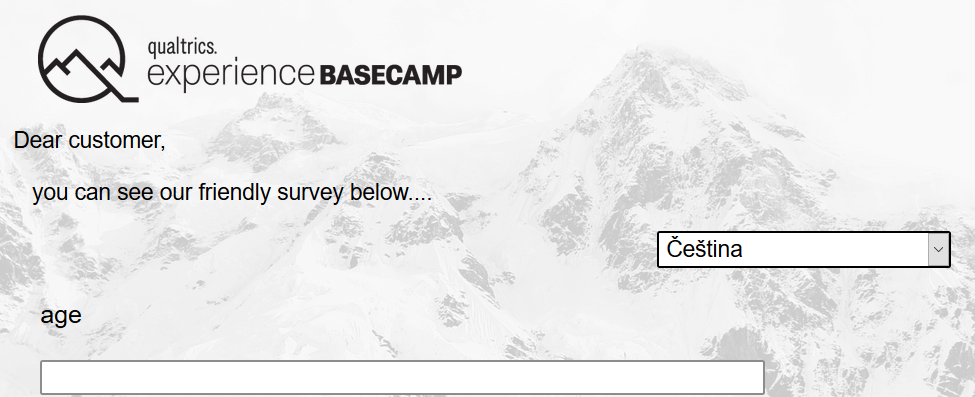 Contact us
Contact us How to easily create a survey language mutation in Qualtrics?
Do you need to translate your survey efficiently and quickly? Is your business open to multi culture and do you often have to use multilingual research?
Then there is the world´s first experience management platform QUALTRICS.
Qualtrics is a solution that offers not only analysis and collection of information, in which, let’s be honest, we often lose ourselves, but mainly has the ability to respond quickly to results.
Fast responsiveness and promptness are taken for granted in successful companies and therefore it is also necessary and useful to respond to multicultural background, be it customers or employees.
Qualtrics ensures the translation of questions and answers during the creation of the survey/quiz itself.
Let us look at the types of methods that can make this process easier for us.
We all know very well the situation when we must work on a task – an open web for reading mail, an open site for inspiration, and of course youtube to improve your mood.
But Qualtrics does it differently. One of its great advantages is that we do not have to “click through” between surveying and translating. Simultaneously and quickly, we can translate our text in one environment.
Automatic Translation
This is the translation of the text that is already in the created survey (left side). If you select “%”, the text will be translated and changed to “100%” (of course, if all the text in the left window has been successfully translated).
In a similar way, the user can translate all questions in the survey.

Need a survey/quiz with lots of text?
Qualtrics also covers creating with more extensive content, and therefore allows translation import.
The created text can be easily downloaded. If necessary, we translate the text in the downloaded file and import the new version into the survey.
This means that we don’t have to “click” the sentences step by step, but we can translate the file outside Qualtrics.
Text is imported using the option shown on the print screen.

Paid Translations
Do you need a 100% translation, but are not confident with it?
Qualtrics has a solution for this situation as well.
If you are sending your surveys to an external environment, or you don’t have the resources to translate, or otherwise need flawlessly written text, Qualtrics offers an effective solution – the “Paid Translations” option.
After submitting the completed text form, your survey will be professionally translated. The translation expertise is provided by two native speakers.

Defining the language for the participants
In the following, we will describe the methods of choosing the appropriate language for respondents.
Automatic language detection
From the above examples, we already know that one survey can be translated into several languages. If we know that respondents also come from other countries, we can easily see which language to use in the survey through the – Automatic language detection option. Qualtrics detects the language according to the language used in the participant’s browser.
If the language in the browser is the same as the language of the translated survey, it is automatically offered to the respondent.
Entering the language in the contact list
If we know our respondents (for example, employees) and the survey is sent exclusively to the selected people, then the appropriate solution is – Entering the language into your contact list.
It is about entering the desired language for every single person in the contact list offered by Qualtrics. When sending, the exact email addresses (which will contain the language in the contact list) are written and each respondent will see the text in a predefined language.
Creating a survey link for each language
This may be a problem if we need to distribute our survey anonymously. Not for Qualtrics 😊
If the survey is done and the text is translated, we can use this type of distribution – to create a survey link for each language.
This can be useful if we publish our survey on websites with a strong assumption that respondents will use different languages.
In this case, it is necessary to add to the anonymous link:
?Q_Language=
it will be followed by a predefined language marker, e.g.
http://survey.qualtrics.com/jfe/form/SV_cM7uFWAef1IB?Q_Language=KAN
where KAN is the marker for Canada.
Direct language selection
If we want to let the respondents choose their language, we can do this through direct select in the survey.
Our only task will then be to translate the survey and Qualtrics itself will offer participants the languages which the text is translated into.
Example:
The big company decided to distribute a professional quiz for internal people.
Each participant must use English (pre-defined in the browser) on their laptop / mobile phone.
However, another language will be optimal for completing the quiz.
Simple solution – from the very beginning the respondent is able change the language based on direct selection.

In conclusion, we can summarize that Qualtrics offers a quick and effortlessly resolvable translation, whether it be a simple or more complex survey. The user can choose which type will be beneficial for him and save time.
Naturally, we do the translation primarily because of the respondents. Therefore, the platform’s valuable benefit is that it does not have one general language choice solution but offers four types.
We can talk about the intelligent ability to individually identify, design, divide and predefine languages.
Qualtrics has perfectly adapted to the current system of operation of companies, as evidenced by the above methods, which undoubtedly facilitate the creation of surveys. And that is what artificial intelligence should do, isn’t it? 😊
Katarína Kováčiková, CX Consultant


